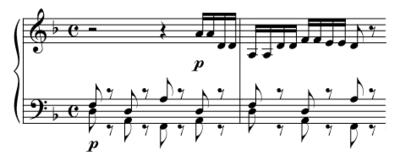- Symphony No. 0 (Bruckner)
-
“Symphony No. 0 in D minor” 
Dedication none Composed 1869 Premiere F. Moissl, 12 October 1924, Klosterneuenburg First published 1924 (ed. Wöss) Other editions ed. Leopold Nowak, 1968 First recording Henk Spruit, Netherlands Philharmonic Orchestra, 1951 This Symphony in D minor composed by Anton Bruckner was not assigned a number by its composer, and has subsequently become known by the German designation Die Nullte (translated to The Zeroth or Number Nought in English).
Contents
Composition
This work is the third symphony composed by Bruckner; experts agree that it was written in 1869, after the Symphony that Bruckner himself regarded as his No. 1 and the earlier Study Symphony in F minor. Bruckner decided this Symphony was not worthy of a number, and declared it "gilt nicht" ("doesn't count") and on one copy of the score put in an empty set symbol (∅), which was later interpreted as a numeral zero. According to the conductor Georg Tintner, this lack of confidence in the work arose from a question by the puzzled conductor of the Vienna Philharmonic Orchestra, Felix Otto Dessoff, who asked Bruckner, "Where is the main theme?".
The work was not premiered until 1924. It is sometimes referred to as "Symphony in D minor, opus posthumous."
Analysis
The score calls for a pair each of flutes, oboes, clarinets, bassoons, four horns, two trumpets, three trombones, timpani, and strings.
It has four movements.
First movement, Allegro
The work begins with an ostinato in the strings that is in D minor.
Leopold Nowak suggested that the answer to Desoff's question is that the principal theme is in the first movement of Symphony No. 3 in D minor, which also begins with an ostinato.
Second movement, Andante
Nowak places all markings of Andante for this B-flat major movement in parentheses.
Third movement, Scherzo: Presto — Trio: Langsamer und ruhiger
This is the last of Bruckner's symphonic scherzos in which the orchestra begins fortissimo. The theme has something of the qualities of the Mannheim rocket, but its chromaticism suggests the future music of Shostakovich.
The Trio's theme in G major has hints of G minor.
Unlike later scherzos, this one has a separate coda for the reprise of the Scherzo.
Fourth movement, Finale: Moderato — Allegro vivace
The movement begins with a slow introduction. The theme in the violins,
is accompanied by semiquavers (i.e. sixteenth notes) in the woodwinds (music that shows up again in the development). This gives way to the main theme of the following allegro-movement,
which does double duty as a third theme. The second theme
reminds some listeners[who?] of Rossini.[1]
Editions
The symphony is available in two editions: by Wöss (published 1924) and Leopold Nowak (published 1968).
Discography
The first commercial recording of the symphony was by Fritz Zaun with the Berlin State Opera Orchestra in 1933. It included only the scherzo, in the Wöss edition.
The first commercial recording of the complete symphony was by Henk Spruit with the Netherlands Philharmonic Orchestra in 1951.
Performances and recordings of the "complete" Bruckner Symphonies often exclude No. 0, most notably excepting the boxed sets of Riccardo Chailly, Eliahu Inbal, Bernard Haitink, Georg Tintner, Gennady Rozhdestvensky, Stanislaw Skrowaczewski and former Chicago Symphony Orchestra conductors Daniel Barenboim and Sir Georg Solti.
Notable Recordings
- Ferdinand Leitner conducting the Bavarian Radio Symphony Orchestra, live performance, 1960, Orfeo (Wöss edition)
- Bernard Haitink conducting the Concertgebouw Orchestra, studio recording, 1966, Philips (Wöss edition)
- Daniel Barenboim conducting the Chicago Symphony Orchestra, studio recording, 1979, Deutsche Grammophon (Nowak edition)
- Georg Tintner conducting the RTÉ National Symphony Orchestra, studio recording, 1996, Naxos (Nowak edition)
- Stanisław Skrowaczewski conducting the Saarbrücken Radio Symphony Orchestra, studio recording, 1999, Arte Nova/Oehms Classics (Nowak edition)
- Tatsuya Shimono conducting the Osaka Philharmonic Orchestra, Live recording, November 17 & 18, 2005, Symphony Hall, Osaka, Avex Entertainment (Nowak edition)
References
Tintner, Georg. Recording notes for Anton Bruckner: Symphonies No. 8 and 0, Ireland National Symphony Orchestra conducted by Georg Tintner. Naxos 8.554215-16.
- ^ Anonymous. Recording notes for Bruckner: Symphony No. 0 and Motets, SWR Stuttgart Radio Symphony Orchestra, conducted by Sir Neville Mariner.
External links
Symphonies by Anton Bruckner Categories:- Symphonies by Anton Bruckner
Wikimedia Foundation. 2010.







